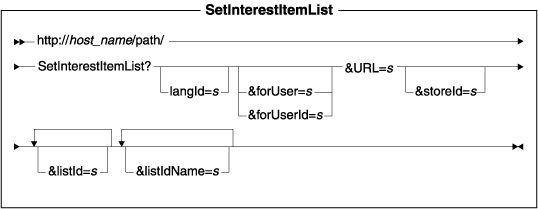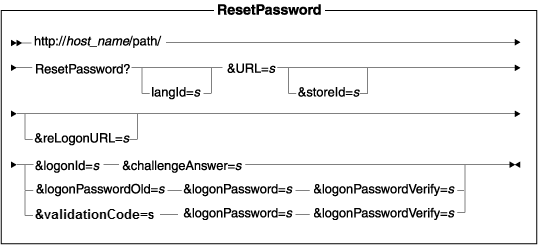Basic URL syntax
All HCL Commerce shopping flow URLs follow the same basic syntax.
http://host_name/path/Command?parameter1=value¶meter2=value¶meter3=value
Here is an illustration:

To read these railroad-style syntax diagrams, start in the upper left corner, and follow the line (think of it as a railroad track). Keep in mind the following conventions:
- The host_name and the path are determined based on how
HCL Commerce is installed. The host_name is the fully qualified name of
your HCL Commerce Server. The path is the configuration path. For
example,
Where myhostname is the host_name for the URL, and webapp/wcs/stores/servlet/ is the path.http://myhostname/webapp/wcs/stores/servlet/DynaCacheInvalidation?clear=true - The delimiter after the command name is ?. The delimiter between successive parameters is &. You do not have to use the & before the first parameter. The value of the parameter is typically given in the syntax diagrams as either S for string, or I for integer. If a parameter can have a value of only true or false, the default value is specified in the diagram. If a parameter requires predefined codes or if it places non-obvious restrictions on data type, this requirement or restriction is explained in the description. When you read the line from left to right, any parameter that is on the main line, such as URL cannot be avoided. This location of a parameter identifies that the parameter is mandatory.
- If a parameter is off the main line, such as langId, and can be avoided, the parameter is optional.
- If a parameter has a line that returns to the left site, such as listId, it
indicates that the parameter can be used repeatedly, For
example:
&listId=1&listId=2&listId=3
The next syntax diagram illustrates alternative sets of mandatory parameters: you either
use:
&logonId=s&challengeAnswer=s
Or else you
use
&logonPassword=s&logonPasswordOld=s&logonPasswordVerify=s

Parameter values
Some common parameters are available to most of the commands:
- storeId
- Associates the command with a specific store. This store association is especially useful with commands that operate at the mall level because it forces the command to operate within the scope of only the store.
- langId
- Specifies the language that is used during the command. The values for the parameter are stored in the LANGUAGE table. The language that is specified overrides the user default language if supported. Otherwise, if the specified language is not supported, then the store or site default language is used.
- forUser
- Specifies logon ID of a user for whom actions are being taken by another user. The parameter can
be used only by a person with the authority to process orders, such as a Customer Service
Representative, Customer Service Supervisor,
 Operations Manager,
Operations Manager,  Logistics Manager,
Logistics Manager,  Merchant, or
Merchant, or  Seller. The parameter is useful in a call center setting if a customer requests assistance
with completing a purchase. The call center operator then logs in and completes the order by using
the identify of the calling customer.
Seller. The parameter is useful in a call center setting if a customer requests assistance
with completing a purchase. The call center operator then logs in and completes the order by using
the identify of the calling customer. - forUserId
- Same as forUser, but identifying the user by the internal user ID, as found in the USERS table.
- URL
- The web address that is called when the command succeeds. The value for this parameter is determined as follows: Start with the input parameters to the command, except URL. Add, replacing when a name conflict occurs, any additional name-value pairs that are produced by this command. Finally, add, replacing when a name conflict occurs, the name-value pairs found in URL.
- errorTaskView
- The name of the view to which the browser is redirected if any problems occur. If not specified, then the default error view that is associated with a particular exception is used.
Example
In the example of a URL, the URL often spans multiple lines. For readability, they are arranged like the following URL:
http://myhostname/webapp/wcs/stores/servlet/AddressUpdate?addressId=128
&firstName=Jeffery&URL=/webapp/wcs/stores/servlet/
A URL command typically appears on a single line.